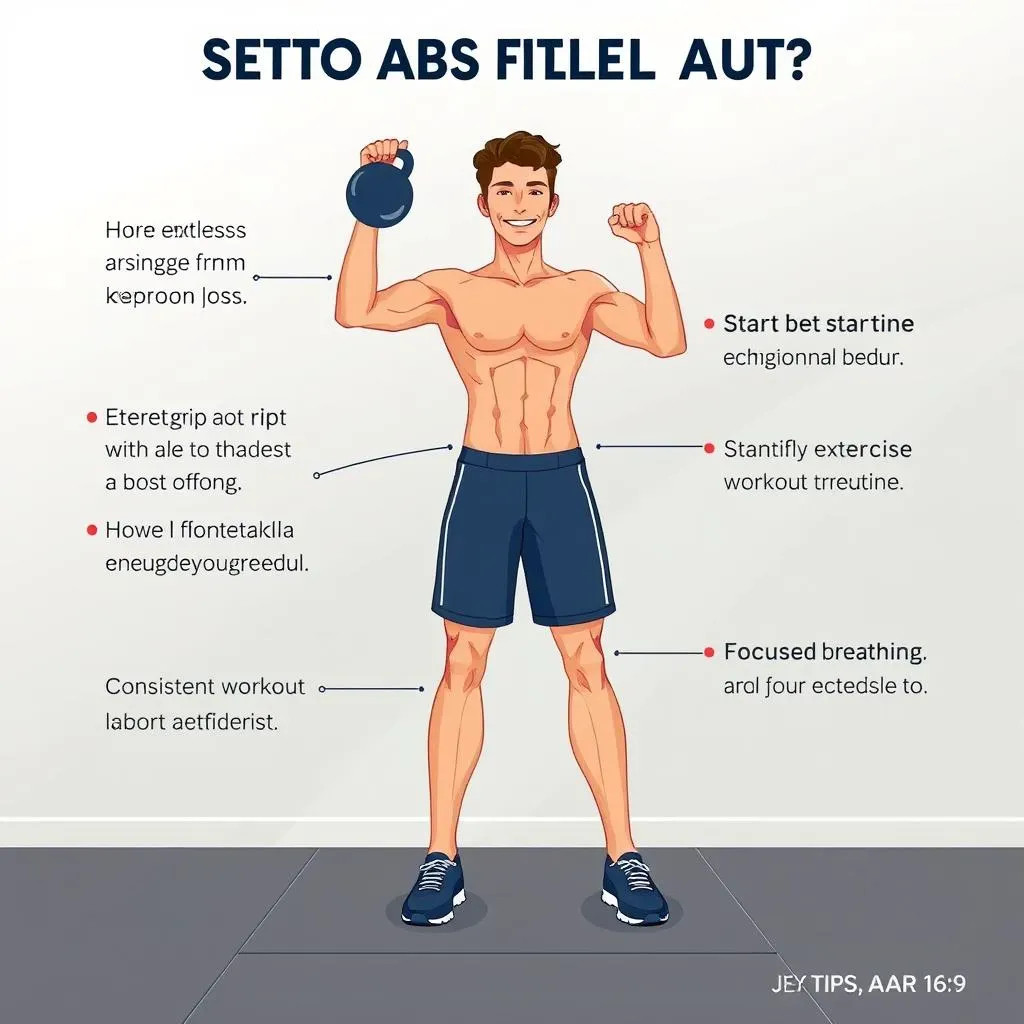Table of Contents
Tired of endless crunches and planks? I get it. Let's face it, floor-based ab work can be a real drag. But what if I told you there's a way to build a rock-solid core without ever having to lie down? Enter the standing kettlebell ab workout. This isn't your grandma’s workout routine; we're talking dynamic, functional movements that'll torch your abs, strengthen your obliques, and improve your overall stability – all while you're on your feet. We’re going to explore five killer exercises using just a single kettlebell. I’ll show you how to correctly perform each move, and I'll even give you a simple workout plan to get you started. Forget the boring sit-ups; it's time to stand up for your abs! So, if you are ready to ditch the floor and discover a new way to train your core, keep reading.
Standing Tall: Why Kettlebells Are Great for Abs

Standing Tall: Why Kettlebells Are Great for Abs
Beyond the Crunches: Functional Core Strength
Let's be real, crunches are boring, and they only hit a small part of your core. Kettlebells change the game by engaging your entire midsection. When you’re standing, your core has to work harder to stabilize your body, especially when you're swinging or lifting a kettlebell. It’s not just about those six-pack muscles; it’s about your obliques, transverse abdominis, and even your lower back. This means you're not just building a pretty six-pack, you're creating real functional strength that’ll help you in everyday life, from picking up groceries to playing with your kids. Think of it like this: you're not just working out, you're building a more resilient, powerful version of yourself.
I remember when I first started with kettlebells. I was so used to isolating my abs with crunches, that I didn’t even realize how much I was neglecting all those other important muscles. The first time I tried a kettlebell swing, I felt my entire core light up like a Christmas tree. That's the beauty of standing kettlebell exercises; they force your core to work as a unit, not just a collection of isolated muscles. You will not only look better, but you'll also move better and feel more powerful in everything you do.
Why Standing is Superior: Stability and Real-World Application
The thing about floor exercises is that, well, you're on the floor. Great for isolating muscles, but not so great for real-world strength. Standing kettlebell work, on the other hand, forces you to use your core to stabilize your entire body. This mimics how you move in everyday life. Think about walking, carrying things, or even just standing up straight. These all require core engagement, and standing kettlebell exercises train those specific muscles. Plus, who wants to spend all their time on the floor when you can be up and moving? It's about building a core that's strong and functional, not just one that looks good in a mirror.
I know what you might be thinking: "Is this really going to be as effective as my usual routine?" Trust me, it is. I've seen people who spend hours doing crunches and sit-ups, and they don’t get half the results that you can get with a consistent standing kettlebell ab workout. It's not just about the exercises themselves; it’s about the way they engage your entire body. You're not just working your core, you're improving your balance, coordination, and overall strength. So, ditch the floor, grab a kettlebell, and let's get to work.
Benefit | Description |
|---|---|
Functional Strength | Engages the entire core for real-world movements. |
Improved Stability | Enhances balance and coordination. |
Full-Body Workout | Works more than just your abs, improving overall strength. |
Time-Efficient | More effective than traditional isolation exercises. |
The 5Move Standing Kettlebell Ab Workout

The 5Move Standing Kettlebell Ab Workout
Suitcase Marches: Stability and Core Control
Alright, let's kick things off with Suitcase Marches. This move might look simple, but trust me, it's a core crusher. You'll hold a kettlebell in one hand, like you're carrying a suitcase, and march in place. The key here is to keep your core tight and your body upright. Don't let the kettlebell pull you to one side; resist that urge. It's all about controlled movement and maintaining stability. This exercise is amazing for strengthening your obliques and teaching your core to resist rotation. I remember when I first started, I felt like I was going to tip over, but with practice, it became a staple in my routine. It’s also great for improving balance and coordination, which is super useful in everyday life.
Think of it like this: you're not just marching; you're actively engaging your core to stay balanced. The kettlebell acts as a constant reminder to keep those muscles working. Start with a lighter weight if you're new to this, and focus on maintaining good form. As you get stronger, you can gradually increase the weight. This exercise is all about quality over quantity. You want to feel that core engagement, and trust me, you will. It’s also a sneaky way to sneak in some cardio while you're at it. You will be surprise how much this will burn your core.
Kettlebell Halos: Circular Core Strength
Next up, we’ve got Kettlebell Halos. This exercise is like a dance for your core. You'll hold the kettlebell by the horns and circle it around your head, making a halo shape. Keep your core tight and your movements controlled. This isn't about speed; it's about engaging your entire midsection. It's a fantastic way to improve shoulder mobility and core strength simultaneously. I was surprised how much my obliques were working when I first tried this exercise. It might feel awkward at first, but with a little practice, it becomes a smooth and effective movement.
The key to a good Kettlebell Halo is to keep your body stable as you circle the weight around your head. Avoid swaying or leaning to one side. Your core should be the anchor that keeps you centered. This exercise is excellent for improving core stability and strength, and it's also a great warm-up for your shoulders and back. Think of it as a way to wake up your entire upper body. Just remember to keep your movements slow and deliberate, and you'll feel the burn in no time. It's a great exercise and you will feel it after.
Exercise | Focus | Benefits |
|---|---|---|
Suitcase Marches | Obliques, Core Stability | Improved balance, core strength, and stability. |
Kettlebell Halos | Shoulder Mobility, Core Strength | Improved shoulder mobility, core stability, and strength. |
How to Do Each Standing Kettlebell Exercise

How to Do Each Standing Kettlebell Exercise
Kettlebell Windmills: Core and Hip Flexibility
Alright, let's talk about Kettlebell Windmills. This one is a bit more complex, but it’s so worth it. Start with your feet shoulder-width apart and hold the kettlebell in one hand overhead. Now, hinge at your hips, push your butt back, and lower your free hand towards the ground. Keep your eyes on the kettlebell as you go down, and make sure your back stays straight. It's like you're trying to touch the floor with your free hand, but you're also reaching for the ceiling with your kettlebell hand. This move is fantastic for improving core strength, hip flexibility, and shoulder stability. It might feel a little awkward at first, but with practice, it becomes a smooth and powerful movement. I remember the first time I tried this, I was so wobbly, but now I love it.
The key to a good Kettlebell Windmill is to control the movement and keep your core engaged. Don’t just flop down; think about actively reaching for the floor while maintaining that straight line from your hand to your feet. This exercise is great for strengthening your obliques and improving your overall core stability. Plus, it's a great way to stretch out your hips and hamstrings. Start with a lighter weight until you feel comfortable with the movement, and then gradually increase the weight as you get stronger. It’s all about feeling the engagement in your core and controlling the movement. The important thing is to do it properly to get the most out of it.
Kettlebell Hand-to-Hand Passes: Dynamic Core Engagement
Next up, we have Kettlebell Hand-to-Hand Passes. This exercise is all about dynamic core engagement. You’ll start by holding the kettlebell in one hand, and then you’ll pass it to the other hand in front of your body, while maintaining a tight core. It’s like you’re juggling, but with a kettlebell. The key here is to keep your core tight and avoid twisting your body. It’s all about smooth, controlled movements. I found this exercise really improved my core stability and coordination. It may sound simple, but trust me, it's a real core burner.
Think of it like this: you're actively engaging your core to control the kettlebell as you pass it from hand to hand. The goal is to avoid any jerky movements and keep your body stable. This exercise is excellent for improving core strength, coordination, and overall body control. Start with a lighter weight until you feel comfortable with the movement, and focus on keeping your core tight and your body stable. It’s not about speed; it’s about control and precision. It is one of the most fun exercises on this list.
Exercise | Focus | Benefits |
|---|---|---|
Kettlebell Windmills | Core Strength, Hip Flexibility | Improved core strength, hip flexibility, and shoulder stability. |
Kettlebell Hand-to-Hand Passes | Dynamic Core Engagement | Improved core strength, coordination, and body control. |
Kettlebell Openers: Full Core Activation
Finally, let's finish with Kettlebell Openers. This exercise is a great way to wrap up our workout. You'll hold the kettlebell in front of you with both hands, and then you'll open your arms out to the sides, keeping your core tight and your back straight. It's like you're opening a big book, but with a kettlebell in your hands. This exercise is great for engaging your entire core, from your abs to your obliques, and it also works your shoulders and chest. I remember when I first tried this, I felt like my core was on fire. It’s a great way to finish up a standing kettlebell ab workout.
The key to Kettlebell Openers is to keep your core tight and your movements controlled. Avoid swinging your arms around; think about actively engaging your core as you open your arms. This exercise is excellent for improving core strength, shoulder stability, and overall body control. Start with a lighter weight until you feel comfortable with the movement, and then gradually increase the weight as you get stronger. It's all about feeling that full core activation and maintaining good form. You want to feel it in your whole core, not just your arms. Keep in mind, doing it properly is better than doing it fast.
Putting It All Together: Your Workout Plan

Putting It All Together: Your Workout Plan
Okay, so now you know the moves, but how do you actually put them into a workout? I've got you covered. We're going to use an EMOM format, which stands for "every minute on the minute." It's a simple and effective way to structure your workout. You'll perform a set number of reps of each exercise at the start of each minute. Then, you'll rest for the remainder of that minute. When the next minute starts, you move on to the next exercise. This keeps the workout moving and helps you maintain a good pace. I remember when I first started with EMOM, I was surprised how much it pushed me, even with lighter weights. It’s a great way to build endurance and strength at the same time.
Here's the plan: we're going to do a 5-round circuit. Each round will consist of one minute of each exercise. So, at the start of the first minute, you’ll do 10 Suitcase Marches on each side. Then, you’ll rest for the rest of the minute. When the second minute starts, you'll do 10 Kettlebell Halos. Then you rest again. You will repeat this pattern for each of the five exercises. Once you’ve completed one round of the 5 exercises, you repeat it 4 more times. That’s your workout! It’s simple, but it’s incredibly effective. Remember, the key is to keep your form good, even when you get tired. Don’t rush it, focus on doing each exercise properly.
Minute | Exercise | Reps |
|---|---|---|
1 | Suitcase Marches | 10 each side |
2 | Kettlebell Halos | 10 |
3 | Kettlebell Windmills | 5 each side |
4 | Kettlebell Hand-to-Hand Passes | 10 |
5 | Kettlebell Openers | 10 |
Tips for Success with Your Standing Kettlebell Ab Workout

Tips for Success with Your Standing Kettlebell Ab Workout
Alright, so you're ready to rock this standing kettlebell ab workout. That's awesome! But before you jump in, let's talk about some key tips to make sure you're getting the most out of it and staying safe. First things first, grip strength is crucial. You need a solid grip on that kettlebell to maintain control and avoid any mishaps. If you’re new to kettlebells, start with a lighter weight and really focus on your form. It’s way better to do the exercises correctly with a lighter weight than to try and lift heavy with poor form. I remember trying to show off with a heavy kettlebell when I first started, and it ended up with me barely able to move for the rest of the day. Trust me, it's not worth it. Also, don't be afraid to modify the exercises if you need to. If something doesn't feel right, don't push through it. Listen to your body, and adjust as needed. These tips will help you with your journey.
Another big thing is consistency. You're not going to see results overnight. It takes time and effort to build a strong core. So, stick with it, and you'll get there. Try to do this workout a few times a week, and you'll start to notice a difference in your core strength and stability. Also, remember to breathe. It sounds simple, but it's easy to hold your breath when you're working hard. Focus on your breathing, and it will help you maintain your form and get the most out of each rep. And hey, don't forget to have fun with it. This workout can be challenging, but it's also incredibly rewarding. Enjoy the process, and celebrate your progress. You're doing great!
Tip | Description |
|---|---|
Grip Strength | Maintain a solid grip for control and safety. |
Start Light | Begin with a lighter weight and focus on form. |
Modify When Needed | Adjust exercises to suit your needs and limitations. |
Consistency | Stick with the workout regularly for best results. |
Breathe | Focus on breathing to maintain form and endurance. |
Have Fun | Enjoy the process and celebrate your progress. |
Wrap Up: Standing Strong with Kettlebells
So there you have it, five powerful standing kettlebell exercises that can transform your core strength. This isn't just about vanity; a strong core improves everything from your posture to your balance. By incorporating these moves into your routine, you're not just working your abs, you’re building a foundation for overall fitness. Remember, consistency is key. Start slow, focus on your form, and gradually increase the weight as you get stronger. Don't be afraid to experiment, find what works best for you, and most importantly, have fun with it. Your journey to a stronger core starts now - standing tall, with a kettlebell in hand.